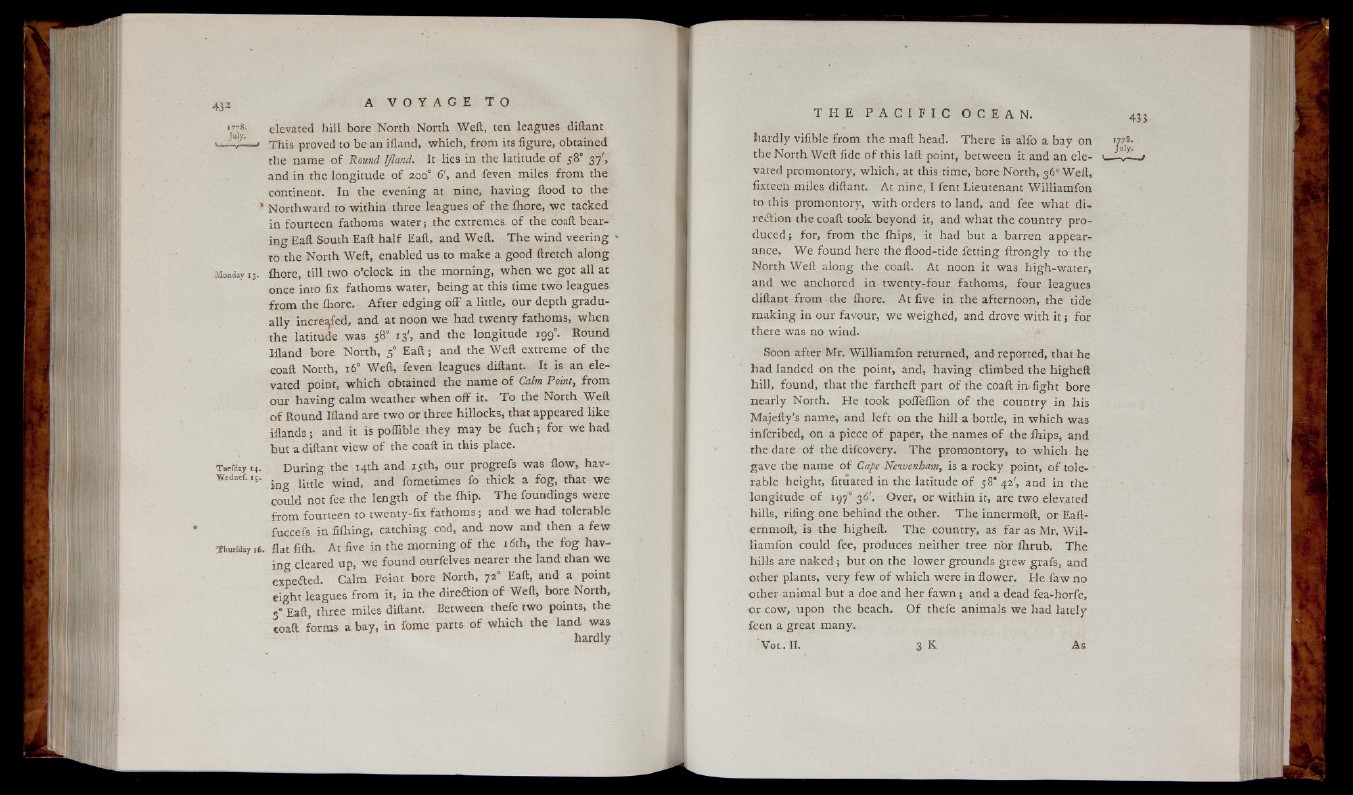
1 7 7 8 . elevated h ill bore North North Weft, ten leagues diftant
<— —• This proved to b e an ifland, which, from its figure, obtained
the name o f Round Ijland. It lies in the latitude o f 5.8° 37',
and in the longitude o f 200° 6', and feven miles from the
continent. In the evening at nine, ha vin g flood to the
* Northward to within three leagues o f the fhore, we tacked
in fourteen fathoms water; the extremes o f the coaft bearin
g Eaft South Eaft h a lf Eaft, and Weft. T h e wind veering
to the North Weft, enabled us to make a good ftretch along
Monday i3. fhore, till two o’clock in the morning, when we got all at
once into fix fathoms water, be in g at this time two leagues
from the fhore. A fte r edgin g o ff a little, our depth grad ua
lly increafed, and at noon we had twenty fathoms, when
the latitude was 58° 13', and the longitude 199°. Round
Ifland bore North, 5° E a ft ; and the Weft extreme o f the
coaft North, 16° Weft, feven Leagues diftant. It is an elevated
point, w hich obtained the name o f Calm Point, from
our h a vin g calm weather when o ff it. T o the North Weft
o f Round Ifland are two or three hillocks, that appeared lik e
iflands; and it is poflible they ma y be fu ch ; for we had
hut a diftant view o f the coaft in this place.
Taefday,+. During, the 14th and tyth, our progrefs was flow, hav-
Wednef..,5. ^ j\u lc wind) and fometimes fo thick a fo g , that w e
could not fee the length o f the fhip. T h e foundings w e r e
from fourteen to twenty-fix fa th om s ; and we had tolerable
fuccefs in fifhing, catching cod, and now and then a f ew
T h u r fd a y : i . flat fifh. At five in the morning o f the 16th, the fo g havin
g cleared up, we found ourfelves nearer the land than we
expedled. Calm Point bore North, 72° Eaft, and a point
eight leagues from It, in the diredion o f Weft, bore North,
3' Eaft, three miles diftant. Between thefe two points, the
toaft forms a b ay, in fome parts o f w h ich the land w as
hardly
hardly vifible from the maft head. The re is alfo a bay on >778.
the North Weft fide o f this laft point, between it and an ele - ■ ’ •
vated promontory, w hich, at this time, bore North, 36° Weft,
fixteen miles diftant. At nine, I fent Lieutenant Wiiliamfon
to this promontory, with orders to land, and fee what direction
the coaft took beyond it, and what the country produced
; for, from the fhips, it had but a barren appearance.
W e found here the flood-tide fetting ftrongly to the
North Weft along the coaft. At noon it was high-water,
and we anchored in twenty-four fathoms, four leagues
diftant from the fhore. A t five in the afternoon, the tide
m a k in g in our favour, we weighed, and drove with i t ; for
there was no wind.
Soon after Mr. Wiiliamfon returned, and reported, that he
had landed on the point, and, having climbed the higheft
h ill, found, that the fartheft part o f the coaft in fight bore
n early North. He took poflellion o f the country in his
Majefty’s name, and le ft on the h ill a bottle, in which was
infcribed, on a piece o f paper, the names o f the lhips, and
the date o f the difcovery. T he promontory, to which he
gave the name o f Cape Neivenham, is a rock y point, o f tolerable
height, fituated in the latitude o f 58* 42', and in the
longitude o f 197° 36'. Over, or within it, are two elevated
hills, riling one behind the other. T he innermoft, or Eaft-
ernmoft, is the higheft. T h e country, as far as Mr. Wil-
liamfon could fee, produces neither tree nor fhrub. The
hills are naked ; but on the lower grounds grew grafs, and
other plants, ve ry few o f which were in flower. He faw no
other animal but a doe and her f a w n ; and a dead fea-horfe,
o r cow, upon the beach. O f thefe animals we had lately
feen a great many.